Comets have been scarce since NEOWISE departed the scene. Not anymore. Suddenly, there are four fresh faces visible from dusk til dawn.
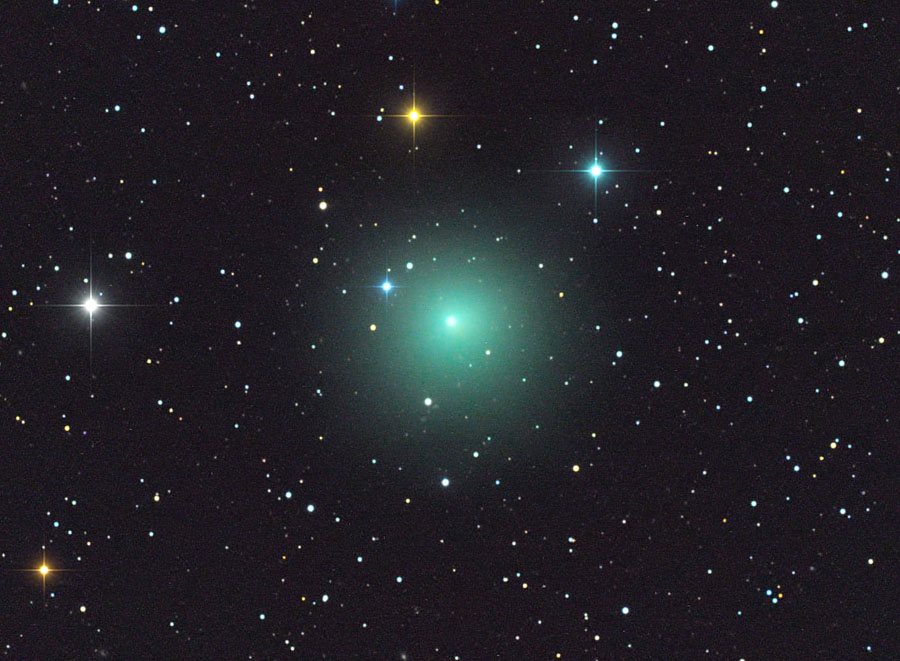
Rolando Ligustri
After the summertime spectacle of Comet NEOWISE (C/2020 F3) the sky quickly emptied of easy-to-see comets for Northern Hemisphere observers. But in recent weeks a whole new crew has assembled to enliven the nights. There are currently four comets within range of amateur telescopes — periodic comet 156P/Russell-LINEAR in the evening sky and Comets ATLAS (C/2020 M3), Erasmus (C/2020 S3), and NEOWISE (C/2020 P1) visible in the early morning hours.
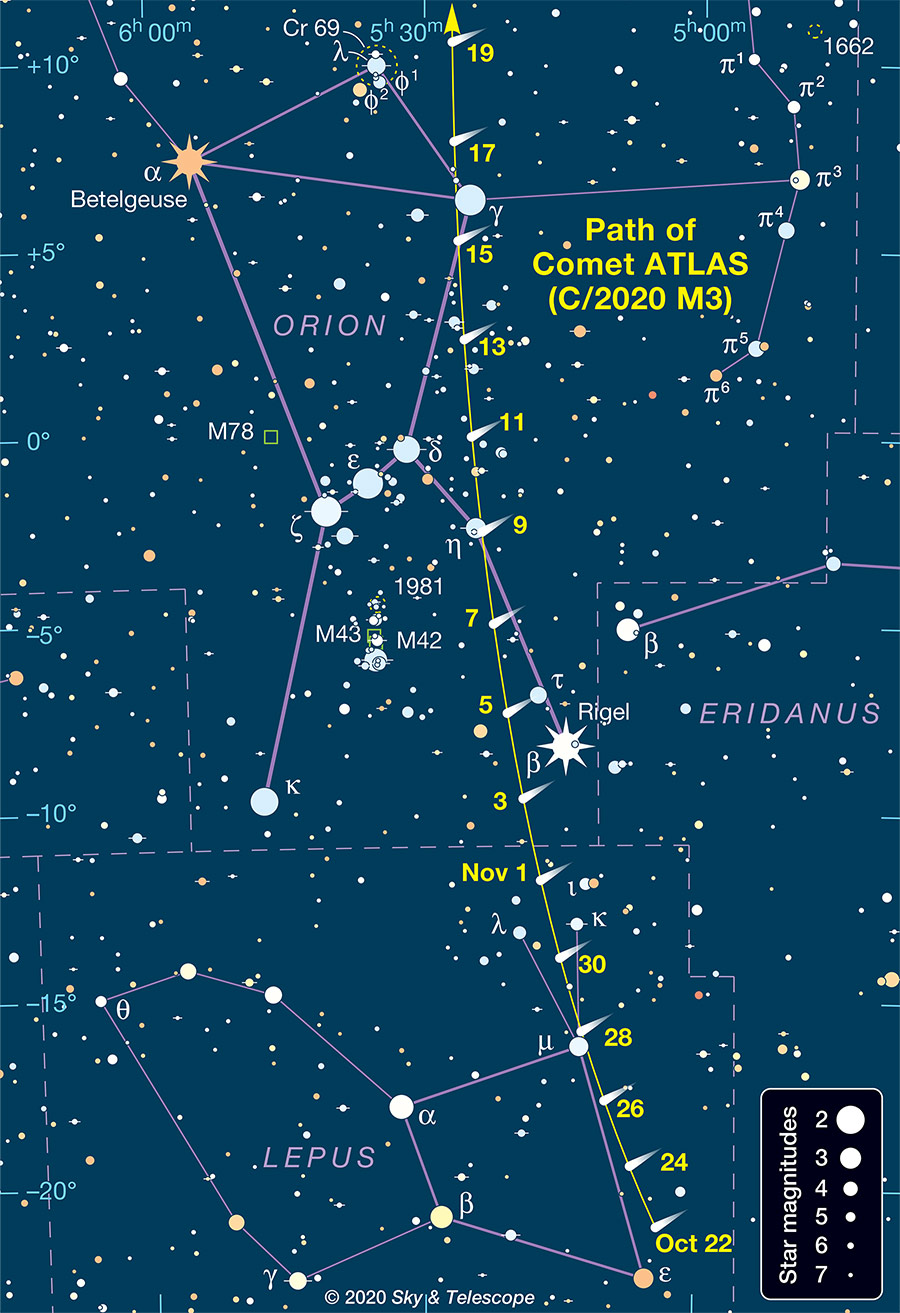
Sky & Telescope
Let's start with Comet ATLAS, the brightest of the quartet. Discovered at magnitude 19 on June 27, 2020, by the Asteroid Terrestrial-Impact Last Alert System (ATLAS) search program it's now about magnitude 8.5 and speeding northward from Lepus toward Orion.
Although the comet rises around midnight you'll see it best around 4 a.m. when it culminates in the south. I observed ATLAS with my 15-inch Dob on October 16th from a semirural sky and was immediately struck by how big and fluffy it appeared, like a big wad of cotton candy.
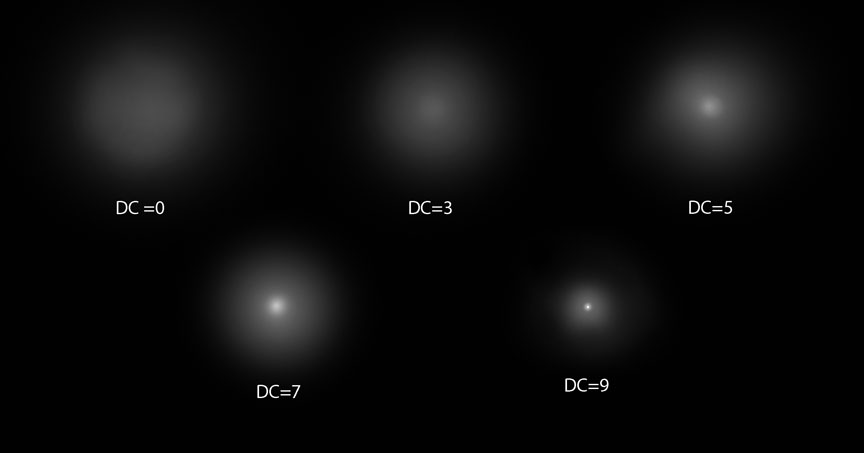
Bob King
I estimated a coma diameter of 11′ with a degree of condensation (DC) of 3 on a scale from 0 (diffuse coma of uniform brightness) to 9 (stellar or disk-like appearance). Increasing the magnification to 245× uncovered a near-stellar pinpoint at center, the so-called false or pseudo-nucleus. A comet's true nucleus is tiny and well-hidden within a self-made cocoon of dust.
While the comet's overall magnitude is relatively bright, its diffuse appearance and large diameter make it look dimmer than you might expect — especially if you're battling light pollution. That said, I've heard of several recent binocular sightings, including one made by Comet Hale-Bopp co-discoverer Alan Hale of New Mexico who spotted it in his 10×50s on October 15th.
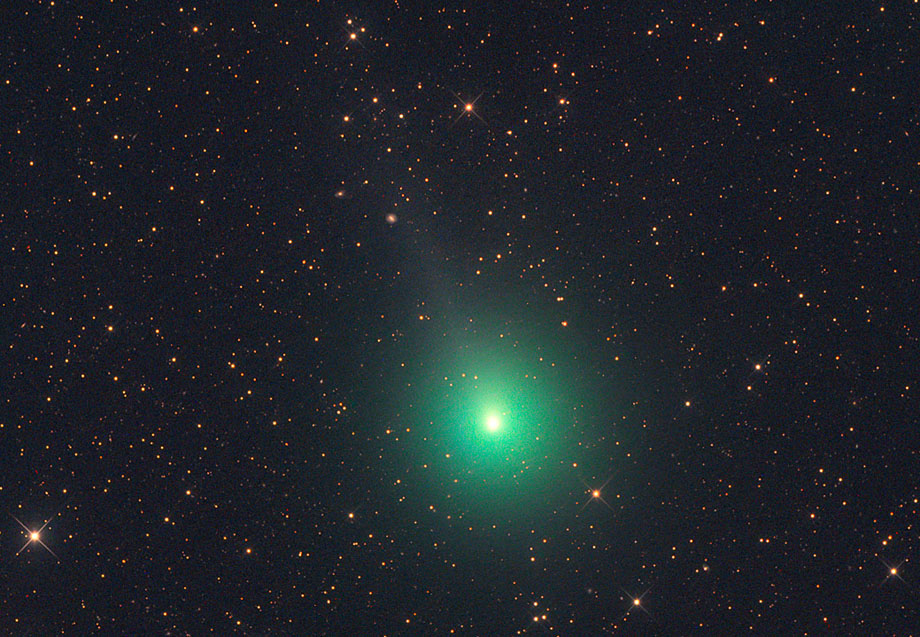
During my observation I discovered that a Swan Band filter — designed to pass the green light of diatomic carbon in gas-rich comets — clearly enhanced ATLAS's contrast and visibility. The comet should remain around 8th magnitude through early December as it climbs steadily northward from Lepus through Orion and into Auriga. Your best viewing opportunities are now through October 29th before the Moon returns and again from November 7–29.
Perihelion occurs on October 25th when Comet ATLAS will pass 1.27 a.u. (190 million kilometers) from the Sun, followed by its closest approach to Earth on November 14th at a distance of 53.6 million kilometers. ATLAS glides within ½° of Mu (μ) Leporis on October 27th and 1° east of Rigel on November 4th.

SAAO
After you've successfully spotted ATLAS, swing your scope east to Hydra to find Comet Erasmus (C/2020 S3). Nicolas Erasmus, an astronomer at the South African Astronomical Observatory, discovered the comet at magnitude ~18.5 on September 20th this year. It's brightened quickly and currently glows around magnitude 11. During its plunge to a December 13th perihelion (0.4 a.u.) the comet could reach magnitude 7–8 by late November.
Right now, it's well placed in Hydra and Sextans just before the start of morning twilight, but its elongation is steadily decreasing. By late next month Comet Erasmus will become more challenging, standing just a fist high in southern Virgo at the start of dawn. Hopefully its declining altitude will be offset by a concurrent increase in brightness, helping to keep it in view even into early December before it's lost in the solar glare.
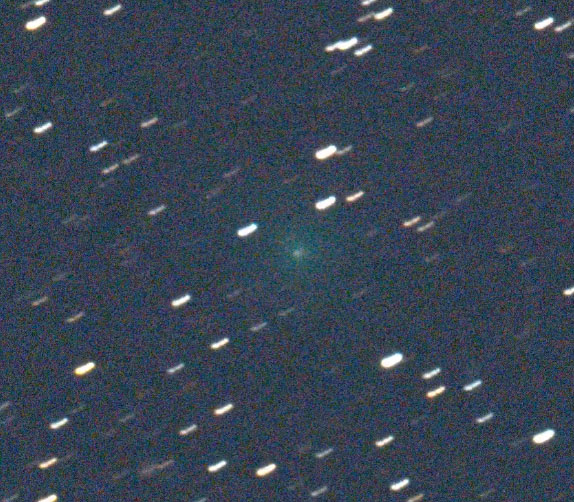
Michael Jaeger
On October 16th I easily swept up Comet Erasmus at low magnification (64×) as a soft, milky patch of light glowing at magnitude 11.5. Its diffuse coma spanned 3′ with a DC of 3. Like for ATLAS, the Swan Band filter nicely boosted the comet's visibility.
Comet Erasmus travels through galaxy-rich territory during the next month, providing several opportunities for photogenic pairings with deep-sky objects. Perhaps the most interesting appulse occurs on November 17th when it passes just ½° north of the bright planetary nebula NGC 4361 in Corvus. At year's end the comet moves into the evening sky and fades rapidly.
Comet NEOWISE (C/2020 P1) will arrive on the scene this week just days after its October 20th perihelion when it approached the Sun at a distance of around 0.34 a.u. NEOWISE is a small comet but assuming it survives perihelion could be as bright as magnitude 8.
Due to its small elongation from the Sun you'll need a location with a clear view to the east-northeast, toward Virgo. Time your observation to the start of morning twilight or about 90 minutes to 2 hours before sunrise to catch this NEOWISE relation (by name only!). The comet will fade as it hurries north into Boötes.
We head over to the evening sky for our final comet, 156P/Russell-LINEAR. Located in southern Aquarius in late October it creeps steadily to the northeast, crossing into Pisces on November 15th and remains in that constellation through the end of the year.
I scoped it out in Sculptor on October 12th at ~13.0 magnitude with a small, well-condensed central coma that measured about 0.5′ across (DC=5). After scrutiny with averted vision I detected a fainter outer coma that increased the total diameter to 1.5′. Other observers have also noticed these two distinct dichotomies — a dense, bright inner coma set within a much larger (up to 5′), low surface brightness outer coma.
Comet 156P/Russell-LINEAR should brighten to magnitude 12 by early November and then slowly fade. If you have an 8-inch or larger telescope and reasonably dark skies give this one a try. The comet's visibility improves as it moves steadily northward during its run.
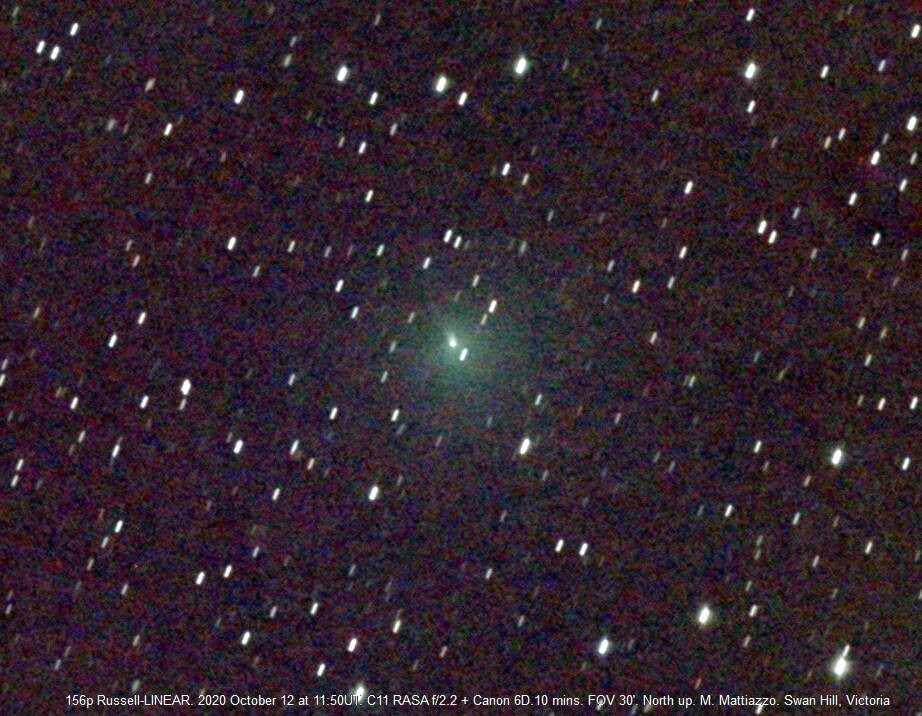
Michael Mattiazzo
Because 156P is already near maximum brightness well before its November 17th perihelion there's speculation it may be undergoing an outburst. As evidence, Michael Mattiazzo's photo from October 12th reveals a pseudo-nucleus off-centered from the coma, something observed routinely during outbursts of Comet 29P/Schwassmann-Wachmann.
Comet 156P/Russell-LINEAR was originally discovered by K. S. Russell at Siding Spring Observatory (Australia) on September 3, 1986, then rediscovered twice in 1993 and 2000 as an asteroid by the LINEAR survey until finally receiving its designation as a periodic comet. You can read more about the comet's convoluted history in Gary Kronk's Cometography.
I've prepared maps of the three fainter comets that you'll find by clicking on the links below. Stars are plotted to magnitude 9 and dates are 0h UT, so remember to subtract 4 hours for Eastern Daylight; 5 for Central; 6 for Mountain; and 7 for Pacific and change the date accordingly. You'll find additional maps for each comet at astro.vanbuitenen.nl and more details at the Comet Observation Database and Seiichi Yoshida's Bright Comets.
156P/Russell-LINEAR
C/2020 S3 (Erasmus)
C/2020 P1 (NEOWISE)
Like autumn leaves in the wind, comets are sailing across the sky again. Grab an instrument and try to catch one . . . or two or three or four.
 10
10










Comments
New Jersey Eclipse Fan
October 23, 2020 at 4:17 pm
Thanks for the detailed report, Bob King. Let's hope those comets continue to show up!
You must be logged in to post a comment.
Yaron Sheffer
October 25, 2020 at 9:31 am
Hi Bob,
Your comets nowadays just arrive, move, travel, and crawl... I fondly recall the days when they used to be as fast as a roadrunner or as a speeding bullet 😉
Many years ago I used to chase each of them, if bright enough. Being older, I appreciate slower comets! But, alas, my local skies have gotten much brighter, too. So no more rewarding chasing 🙁
You must be logged in to post a comment.
Bob KingPost Author
October 25, 2020 at 1:57 pm
Yaron,
So sorry to hear that. Will you try for ATLAS? It will be very well placed in Orion early next month and 8th magnitude, too.
You must be logged in to post a comment.
Yaron Sheffer
October 28, 2020 at 12:49 pm
Bob, this sounds like a challenge, so I guess I should try 🙂
You must be logged in to post a comment.
Joe Stieber
October 25, 2020 at 9:01 pm
I went to the relatively dark New Jersey Pines on the morning of October 18, 2020, and then again on October 22. In each case I was able to spot C/2020 M3 (ATLAS) with my 15x56 binoculars around 4 am EDT (8 UT). Alas, ATLAS was just a faint smudge at the limit of visibility. On the 18th, I also looked with my 88 mm apo spotting scope (25 to 60x) and it wasn't really any easier to see. On the 22nd, I took a snapshot with my Canon EOS RP mirrorless camera and a 200 mm f/2.8 lens (exposed, 4 seconds at f/2.8, ISO 12,800) and again it was just a faint smudge. I'm hoping to get out with my 16-inch Dob before the moon interferes, but the weather forecast for the next few days doesn't look promising. I suppose I'll have to wait for the moon to pass.
You must be logged in to post a comment.
Science
October 29, 2020 at 10:02 am
Am I missing something, but shouldn't you subtract 4 hours from UT to get Eastern Daylight time?
You must be logged in to post a comment.
Bob KingPost Author
October 29, 2020 at 10:31 am
No, you're correct. Thank you! I'm afraid my brain was already on standard time which begins Nov. 1.
You must be logged in to post a comment.
Dave Mitsky
November 12, 2020 at 2:39 pm
I observed Comet C/2020 M3 (ATLAS) using the Astronomical Society of Harrisburg's Naylor Observatory’s 17” f/15 classical Cassegrain at 116, 170, and 216x on the night of November 9th. The eighth-magnitude comet was still fairly low in altitude and the transparency wasn’t the best but I could definitely see the coma as a faint, diffuse glow. Comet ATLAS M3 was located to the southwest of Mintaka (Delta Orionis) at the time.
I was unable to see the comet with Canon IS 15x50s.
You must be logged in to post a comment.
Rod
November 13, 2020 at 11:28 pm
Bob King, tonight I did view comet C/2020 M3 Atlas using my 90-mm refractor at 71x. It was a faint fuzzy ~ 9-10' angular separation from two stars in the field of view in Orion, TYC109-2637-1 and HIP 25467. the skylive.com reports as mv + 8.1 for viewing. On 11-12th, I had 4 inches of rain move through so did not go out into the fields 🙂 The comet difficult in 10x50 binoculars, easier with the 90-mm refractor at 71x and 1-degree true field of view. I used Stellarium and Starry Night to create a more detailed chart view and used my Telrad for quick location pointing off of Bellatrix a bit more than 2-degrees. At my location tonight, the comet transit near 0200 EST.
You must be logged in to post a comment.
Bob KingPost Author
November 14, 2020 at 12:09 pm
Excellent, Rod! Your view matches mine. It's a funny comet. Looks kind of faint even in a larger scope yet it's visible in binoculars.
You must be logged in to post a comment.
You must be logged in to post a comment.